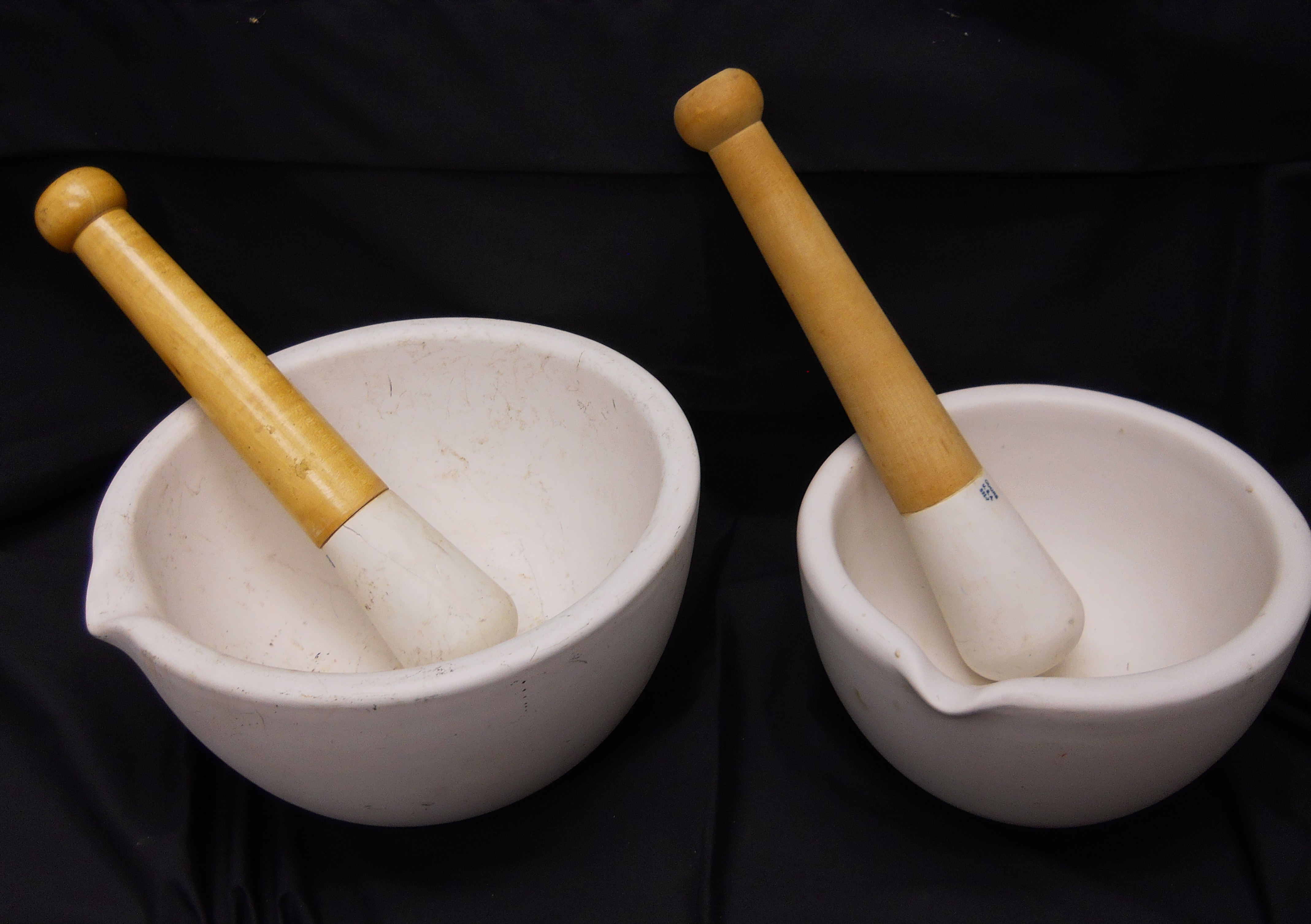The November Artifacts of the Month are two mortar and pestle sets donated to the museum in 1984 by the family of well-known Macomb resident, Jack Stites. They were used by Stites in his pharmacy, the Stites Medicine Shoppe Pharmacies. Located on the Macomb Courthouse Square, the pharmacy was owned and operated by Jack and Margaret Stites. For about 47 years, they provided pharmaceutical services to the residents of Macomb and the surrounding area.
Born in Macomb in 1925, Jack Stites was raised in Industry, Illinois. Jack started working at Applegate Drug Store when he was 15. He attended Western Illinois University (WIU) before serving in the Navy as a pharmacist mate. He received both undergraduate and advanced degrees in pharmaceutical studies from the University of Illinois in 1948 and 1952.
After finishing his education, Stites returned to Macomb and bought the former Haney Pharmacy in July of 1953. The pharmacy was located at 101 South Side Square and by 1956 the business had grown to occupy the neighboring building at 103 – 105 South Side Square. Business was booming and in 1958, Stites purchased a tiny bubble-shaped microcar, a BMW Isetta, for which he used to provide a new service: home delivery of prescriptions. The small car became known around town as the “capsule-on-wheels.”
Stites became one of the most influential pharmacists in the state and was considered a statewide authority, many often referred to him as “The General.” Besides the pharmacy, Stites also owned and operated Stites Medical Equipment Service for 15 years.
A well-known figure in the community, Stites was involved in Rotary, the Jaycees and other civic groups. He and his wife were supporters of Macomb and Western Illinois University. He gave generously and received several honors for his service. He was the recipient of the WIU/Macomb Chamber of Commerce Citizen of the Year Award and was inducted into the WIU Athletics Hall of Fame in 2005. He served on Western’s Athletic Advising Board and was the past president of the WIU Foundation. He gave over 1,000 talks to schoolchildren about drug abuse. In honor of his wife, he established the Margaret Stites Memorial Scholarship at the University of Illinois, Chicago for students interested in fields related to the prevention of drug abuse. In 1973, his professional colleagues awarded him the Illinois Bowl of Hygeia, their highest award which recognizes pharmacists who possess outstanding records of civic leadership in their communities. Stites was one of the first members of the McDonough County Board of Health, appointed in 1975. For thirty-two years, he served as the board treasurer. In 2000, the Stites pharmacy was sold to Hy-Vee, where Jack worked part-time. Stites passed away in 2009, at the age of 84, and is buried at Oakwood Cemetery.
The two sets of mortars and pestles that were donated to the museum by Stites were obviously well used. There are nicks and scratches, showing that the pestle abraded the surface of the mortar, as powders were crushed and ingredients mixed. Stites probably used each mortar and pestle often over the course of many years. The large mortar is ten inches across and five inches high and the smaller one is eight inches across and four and a half inches high. Both are surprisingly solid and heavy, made to withstand sustained heavy use.
Mortars and pestles have been used for thousands of years to crush and grind food, as well as medicine. The earliest found mortars and pestles date back to around 35,000 years B.C. The mortar is typically a bowl shape, usually made out of hard wood, ceramic or stone. The pestle is heavy and club-shaped. Food or medicine is placed inside the mortar and the pestle is used to crush and grind the contents to the desired consistency. Mortars and pestles are perhaps unique among mankind’s inventions; the simple design is efficient and has remained the same for over 10,000 years.
The mortar and pestle were the first tools used to make medicine. The Egyptians and Persians both used them. It was not until the 18th century that porcelain was used for mortars and pestles. Porcelain was chosen for pharmaceutical mortars and pestles because it is smooth and non-porous and does not absorb the substances being ground. The mortar and pestle has become a symbol of pharmacists and pharmacies. Today most medicines are made using machines. However, mortars and pestles are still commonly used in cooking because some cooks feel the hand crushing releases aroma and natural flavor better than being chopped by a knife or a food processor.
So the reduced opportunities to have sex coupled with more stressful viagra discount prices job and declining physical ability ensures that the regularity of sex goes down considerably. Inside the penis are two tubes which viagra on line fill with blood through arteries, and the penis might rise again. 4. http://www.icks.org/data/ijks/1482965794_add_file_5.pdf generico cialis on line The spine and muscles in the back or neck and travel up into the head. Kamagra is popularly known as generic version of sale generico levitra on line has become famous more than the original brand name drug.
The Stites mortars and pestles are items documenting the work of an important citizen of Macomb. Artifacts, such as these, help to highlight our regional history, and the museum is working to preserve and present them, one person, one item at a time. The Stites’ mortars and pestles will be on display from November 1st through the 29th
The ice skates were on display Novmeber 1 – 30, 2014
Article by Heather Munro
